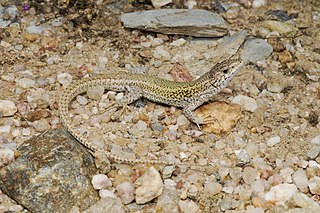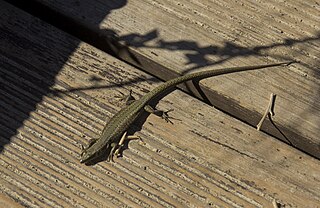
Podarcis is a genus of lizards in the family Lacertidae. Its members look very similar to lizards of the genus Lacerta, to which they were considered to belong until the 1970s. While similar externally and ecologically, Podarcis form a distinct group differing from Lacerta by the construction of the skull and the hemipenis, and by the processes of the caudal vertebrae. They are commonly known as wall lizards. They are native to Europe and northern Africa, and most species are restricted to the Mediterranean region. Wall lizards diversified and hybridized during the Messinian salinity crisis. The Italian wall lizard and the common wall lizard have been introduced to North America, where they have become intermediate hosts for some Acuariidae larvae.

Erhard's wall lizard, also commonly called the Aegean wall lizard, is a species of lizard in the family Lacertidae. The species is endemic to Southeast Europe.

Podarcis muralis is a species of lizard with a large distribution in Europe and well-established introduced populations in North America, where it is also called the European wall lizard. It can grow to about 20 cm (7.9 in) in total length. The animal has shown variation in the places it has been introduced to. Fossils have been found in a cave in Greece dating to the early part of the Holocene.
Local extinction, also extirpation, is the termination of a species in a chosen geographic area of study, though it still exists elsewhere. Local extinctions are contrasted with global extinctions.

Santo Stefano is an island in the Tyrrhenian Sea off the west coast of Italy, and part of the Pontine Islands. It is roughly circular, with a diameter of less than 400 metres, and it is located 2 kilometres east of the nearby island of Ventotene.

The El Hierro giant lizard is the only extant, critically endangered subspecies of Simony's giant lizard. It is endemic to El Hierro, the westernmost of the Canary Islands, where it is an official symbol.

The Ratas Island lizard, Podarcis lilfordi rodriquezi, is an extinct subspecies of Lilford's wall lizard that once lived on Ratas Island, a tiny, rocky island in the bay of Mahón, Menorca (Spain). But Ratas island, which was its habitat, was destroyed when Port Mahon was rebuilt. The last sign of this subspecies was in 1950 and is presumed extinct. Four specimens of this European lizard are conserved in museum collections.
The La Palma giant lizard is a large wall lizard endemic to the island of La Palma in the Canary Islands, currently extinct or critically endangered.
Lorenz Müller was a German herpetologist.

Podarcis carbonelli, commonly known as Carbonell's wall lizard, is a species of lizard in the family Lacertidae. The species is native to Portugal and Spain.

The filfola lizard or Maltese wall lizard is a species of lizard in the family Lacertidae. It is found in Italy and in the island group of Malta. Its natural habitats are Mediterranean-type shrubby vegetation, rocky areas, rocky shores, arable land, pastureland, and rural gardens.

The Skyros wall lizard is a species of lizard in the family Lacertidae. The species is endemic to the islands of Skyros and Piperi, Greece.

Lilford's wall lizard is a species of lizard in the family Lacertidae. The species is endemic to the Balearic Islands, Spain.

The Italian wall lizard or ruin lizard is a species of lizard in the family Lacertidae. P. siculus is native to south and southeastern Europe, but has also been introduced elsewhere in the continent, as well as North America, where it is a possible invasive species. P. siculus is a habitat generalist and can thrive in natural and human-modified environments. Similarly, P. siculus has a generalized diet as well, allowing it to have its large range.

The Tyrrhenian wall lizard is a species of lizard in the family Lacertidae. The species is native to the islands Corsica and Sardinia and their associated islets. There are ten recognized subspecies.

The Sicilian wall lizard is a species of lizard in the family Lacertidae. Endemic to Italy, it occurs in Sicily and the Aegadian Islands. Its natural habitats are temperate forests, temperate shrubland, Mediterranean-type shrubby vegetation, temperate grassland, arable land, pastureland, and rural gardens. The IUCN does not consider it to be a threatened species. Three subspecies are recognized: P. w. antoninoi, P. w. marettimensis, and P. w. waglerianus.

Podarcis virescens, also known by its common name as Geniez's wall lizard, is a lizard species of the Lacertidae family. Podarcis virescens is commonly found in the Iberian Peninsula, including Spain and Portugal. The lizard's name is derived from Latin due to its color turning from a usual brown color to green during the spring. Podarcis virescens are a moderate sized lizard and robust in build. Colors vary during seasons and range between individuals from white, brown, green, and black. Podarcis virescens have been found in villages and other human-populated areas in Spain and Portugal at elevations of around 840 meters.
Endemixit is a project that studies the effects of reduced population size in five Italian endemic species at risk of extinction. The final objective is to estimate the risk of extinction from genomic data and contribute to the preservation of these species. The project was funded by the MUR and coordinated by the Department of Life Sciences and Biotechnology of the University of Ferrara with the involvement of five other Italian universities: Ancona, Florence, Padua, Rome Tor Vergata and Trieste.













